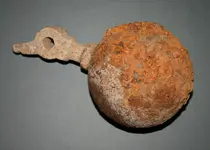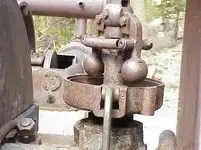As my posting-name indicates, cannonballs (and other 'antique" artillery projectiles are my specialty area of relic study (and collecting, and dealing). Been doing that for nearly 40 years. Very-precise diameter measurement for the ball is crucially necessary for determining whether it is or isn't a cannonball. You'd need to clean ALL of the rust-crust off it to get a truly precise measurement of its diameter: Then go here for detailed instructions (with helpful photos):
SolidShotEssentialsMod
For the meantime, until you can provide precise diameter measurement info... your iron ball appears to have been used as a gate-weight or other version of counterweight.
Using the 15-pound weight and 5"-diameter size you reported (which I assume includes some rust-crust thickness), and "doing the math" on your ball's diameter-to-weight ratio, I calculate that your ball is a solid one ...meaning, not a hollow shell.
As I indicated above, your measurement of the ball with the thick rust-crust on it indicates the diameter will be smaller than 5 inches after the rust-crust is removed. But if the precision measurement of your ball after cleaning turns out to show its diameter is approximately 5.2-inches, there is a possibility that it might have started life as a hollow explosive cannonball ...but if so, having been converted into a counterweight, there definitely won't be any "live" gunpowder left in it.







